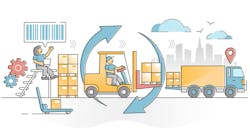Hit the Road to Collaboration
The road to supply chain collaboration is filled with potholes, confusing intersections, bridges under construction and poorly marked detours. Collaboration is a concept, an operational philosophy and a set of principles to guide the enterprise’s relationships with trading partners. It is also key to survival.
What makes collaboration necessary for survival?
A successful enterprise depends on a successful supply chain. To be effective, the supply chain pulls in many suppliers, manufacturers, distribution centers and customers. Each of these supply chain links, or trading partners, has its own requirements and capabilities when it comes to communicating electronically and effectively. Add to this the complication that any enterprise is a member of multiple supply chains, and it’s clear that effective supply chain management is a much greater challenge than many managers expect.
The supply chain collaboration model
The difficulty with collaboration is that it’s about more than just technology; it’s a philosophy that drives the development of relationships with trading partners and encourages mutual trust. Having said that, it is extremely difficult to execute without having the technology in place to enable it to succeed.
The first level of collaboration is the electronic exchange of execution information (orders, shipment status, etc.). It is the connection of the enterprise’s own applications with each other as well as with those of trading partners. This level must cope with all the vagaries of method, media, structure and content.
The second level of the supply chain collaboration model addresses the monitoring of transactions and events. This is more than the simple communication of success/failure that is typical of enterprise application integration (EAI). This monitoring is configurable for each transaction set or for the system in general. This means that specific monitoring attributes can be set for transactions in a unique trading partner relationship. The monitoring can examine the contents of the messages being processed and respond to that content. It is also capable of time-based analysis. Did the shipment occur within the expected time window that allows the container to arrive at the port in time to be loaded onto the scheduled freighter?
This time-based event can also be a non-event; e.g., the system didn’t receive the pickup message from the carrier within the window, therefore the container will miss the boat. None of this monitoring is any good without alarming or notification. These systems are capable of using a series of notification methods, e.g., e-mail, pagers, faxes, etc. Some of the tools are also capable of launching other processes or programs.
The third level of collaboration gives operators the visibility to determine the resolution steps that need to be taken. This level focuses on improved management of the message flow and visibility to the material and orders being processed. It specifically addresses inventory, order and shipment visibility. It gives operations management access to the information needed to resolve exception conditions detected by the global monitoring level. This level also enables ad hoc inquiries by operations and service level management staff.
The fourth level automates these responses and takes corrective action automatically, even notifying the appropriate operators of the actions taken. This level can also recommend options to the operator, allowing him or her to make the final decision on corrective action. This information can also be compiled and used to determine systemic problems that need more thorough corrective action.
Conclusion
The velocity of the business and the complexity of supply chains are driving enterprises to more collaborative trading partner relationships. The old IT architectures with isolated silos of automation, point-to-point integration and inflexible tools to connect with trading partners just don’t cut it. The new supply chain collaboration models provide a manageable architecture to accommodate phased implementations, and flexible trading partner connectivity. This enables full compliance with customer requirements, integration of disparate enterprise applications and easier development of business growth strategies.
About the Author
Thomas K. Ryan is director Systems Integration Services for eSYNC International’s Supply Chain and Enterprise Integration (SCEI) consulting practice. The SCEI practice is focused on assisting enterprises with the difficult task of implementing the technologies necessary to support collaborative supply chain business models. He was most recently the director of technology for Con-Way Logistics, a third-party logistics company. Prior to Con-Way, Tom was a research director at the Gartner Group, an information technology research advisory and analysis firm. He is a member of the Council of Logistics Management and has spoken at Gartner Group Symposia, the Distribution/Computer Expo, the AIAG annual exposition, and at the annual meeting and conference of the Warehousing Education and Research Council. He can be reached at [email protected] or by phone at (630) 876-0607.


